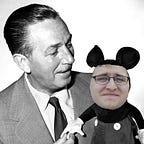Profiles in History: Hershel Melmund, Inventor of the Washcloth
Much is already known about the origins of the hand towel, the napkin and, perhaps most notorious of all, the bib. But scholars have long struggled to find satisfactory answers about beginnings of the washcloth.
This heightened mystique perhaps explains the recent spike in recorded historian drooling after a trove of letters was discovered in the cheeks of a Norwegian dairy farmer, who’d gone to a dentist after 40 years of his wife complaining that his breath smelled of memoir.
The letters, as you may have already inferred, were those of Dr. Hershel Melmund, long speculated — but never before confirmed — to be the father of the modern washcloth.
The letters provide invaluable insight into the early formations of the washcloth (ansiktshåndkle) and the man behind its formation. They are hand-written in Norwegian; an irony, perhaps, because upon reading them it is clear Melmund had no idea how to speak or write in Norwegian.
Born in Dinkelsbuhl, Germany, in 1802, Melmund was the 43rd 1/2 son of Emilia and Hymen Melmund. Emilia worked as a maid for a wealthy butcher and Hymen got work as a human clothes hanger.
His father’s profession was a source of great shame for Melmund, who writes despairingly about seeing his father swinging from a clothes line in a floral dress.
“I bowed my head in shame as he swung there singing the twenty-third verse of ‘99 Bottles of Beer on the Wall,’” Melmund laments in his diary. “It’s the only verse he will sing, believing the others to be anti-Catholic.”
Melmund’s early experiments with the washcloth at university were clumsy and left him filled with anxiety.
“The experiments are going poorly,” he writes in a letter to Marie Fischer, a family friend whose goat, Matilda, Melmund once shared an intimate look with during the Feast of Saint Adalgar. “I cannot get the sizing of the cloth to my satisfaction and it fills me with anxiety,” he continues. “I fear my face — let alone the face of my people — will never be clean. How is Matilda?”
Melmund also struggled to explain his vision for the washcloth to others.
“Kljadnenhreaifi9oceklqw,” he wrote to one of his professors at the University of Hamschmit, seeking funding. “dkljw33ifvkll3409r!”
Despite a hyper-awareness of his pathetic existence, Melmund exhibited a fierce competitiveness with colleagues, particularly Dr. Lars Horfdorfer, who at age 41 had already developed a prototype for what would later become the bathrobe.
“He struts around campus very pleased with his vanity project,” Melmund vents in another letter to Fischer. “As if anyone would wear such an absurd garment! I am cordial with the idiot, but wish him a long, painful death. How is Matilda?”
In April 1851, Melmund suffered a severe burn on his scrotum during the first day of trials to test whether his washcloth prototype could withstand extremely cold water (he’d accidentally started turning the faucet handle the wrong way and, too ashamed to admit the error in front of his assistants, continued turning it the wrong way).
The trials were immediately halted and the injury left him bedridden until 1872.
His breakthrough came in 1884, when he cut a hand towel in half in a drunken rage, forming a perfect 13-by-13-inch square.
“Eureka!” he wrote the next day in his diary. “At long last, I have found the correct size. I am completely rejuvenated; life, it has meaning again. There is so much exciting work to be done!”
He died an hour later from the bubonic plague.
Legal battles over the rights to the historic discovery immediately ensued, until a will was discovered leaving everything to Matilda, who promptly squandered it by eating all the material.
